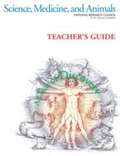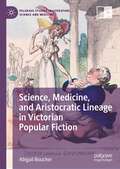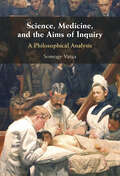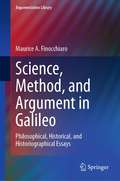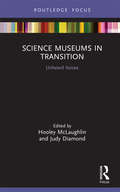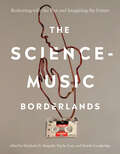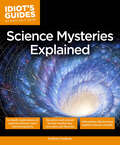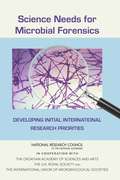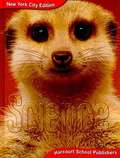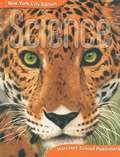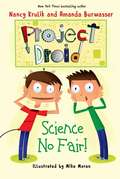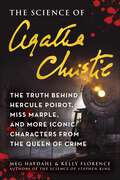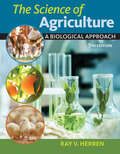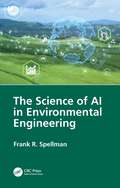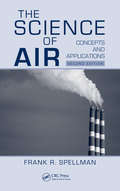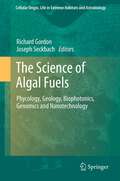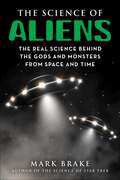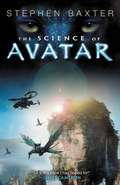- Table View
- List View
SCIENCE Matter and Energy
by Foster; Parker; Shimmin; SteeleScience: Matter and Energy is written from a biblical worldview with the conviction that God is the Creator and Sustainer of the universe. Through this text, students will investigate chemistry and physics topics with the goal of discovering the thoughts of the Creator through the ingenious structure and orderly function of His creation (Psa. 19:1).The biblical worldview of this text naturally rejects the unproven hypothesis of evolution, recognizing special creation as the only reasonable explanation for the origin of life. Through the study of physical science, students will learn that science clearly supports the belief that the universe has a Divine Creator.
Science: Matter and Energy Lab Manual
by Foster; Bunch; Kim; SochVisually reinforce a concept with the Science: Matter and Energy Laboratory Manual. Correlated with the topics contained in Science: Matter and Energy, this manual presents 29 regular labs plus optional appendix labs covering a variety of topics from science investigation and engineering design to physics and chemistry. With each lab, we’ve included a materials supply list, detailed step-by-step instructions, report sheets, and critical thinking questions. Your students will be thrilled to learn with these fun and instructional demonstrations.
Science Matters: Achieving Scientific Literacy
by James Trefil Robert M. HazenKnowledge of the basic ideas and principles of science is fundamental to cultural literacy. But most books on science are often too obscure or too specialized to do the general reader much good.Science Matters is a rare exception-a science book for the general reader that is informative enough to be a popular textbook for introductory courses in high school and college, and yet well-written enough to appeal to general readers uncomfortable with scientific jargon and complicated mathematics. And now, revised and expanded for the first time in nearly two decades, it is up-to-date, so that readers can enjoy Hazen and Trefil's refreshingly accessible explanations of the most recent developments in science, from particle physics to biotechnology.From the Trade Paperback edition.
Science, Medicine, and Animals
by Institute Of Laboratory Animal Research StaffScience, Medicine, and Animals explains the role that animals play in biomedical research and the ways in which scientists, governments, and citizens have tried to balance the experimental use of animals with a concern for all living creatures. An accompanying Teacher’s Guide is available to help teachers of middle and high school students use Science, Medicine, and Animals in the classroom. As students examine the issues in Science, Medicine, and Animals, they will gain a greater understanding of the goals of biomedical research and the real-world practice of the scientific method in general. Science, Medicine, and Animals and the http://www.nap.edu/catalog/11564.html Teacher's Guide were written by the Institute for Laboratory Animal Research and published by the National Research Council of the National Academies. The report was reviewed by a committee made up of experts and scholars with diverse perspectives, including members of the U.S. Department of Agriculture, National Institutes of Health, the Humane Society of the United States, and the American Society for the Prevention of Cruelty to Animals. The Teacher’s Guide was reviewed by members of the National Academies’ Teacher Associates Network. Science, Medicine, and Animals is recommended by the http://www2.nsta.org/recommends/product.asp?id=15858 National Science Teacher's Association.
Science, Medicine, and Animals: A Circle of Discovery
by National Research Council of the National Academieshttp://www.nap.edu/catalog/10733.html Science, Medicine, and Animals explains the role that animals play in biomedical research and the ways in which scientists, governments, and citizens have tried to balance the experimental use of animals with a concern for all living creatures. An accompanying Teacher’s Guide is available to help teachers of middle and high school students use Science, Medicine, and Animals in the classroom. As students examine the issues in Science, Medicine, and Animals, they will gain a greater understanding of the goals of biomedical research and the real-world practice of the scientific method in general. Science, Medicine, and Animals and the Teacher’s Guide were written by the Institute for Laboratory Animal Research and published by the National Research Council of the National Academies. The report was reviewed by a committee made up of experts and scholars with diverse perspectives, including members of the U.S. Department of Agriculture, National Institutes of Health, the Humane Society of the United States, and the American Society for the Prevention of Cruelty to Animals. The Teacher’s Guide was reviewed by members of the National Academies’ Teacher Associates Network. Science, Medicine, and Animals is recommended by the National Science Teacher’s Association http://www2.nsta.org/recommends/product.asp?id=15858NSTA Recommends.
Science, Medicine, and Aristocratic Lineage in Victorian Popular Fiction (Palgrave Studies in Literature, Science and Medicine)
by Abigail BoucherScience, Medicine, and Lineage in Popular Fiction of the Long Nineteenth Century explores the dialogue between popular literature and medical and scientific discourse in terms of how they represent the highly visible an pathologized British aristocratic body. This books explores and complicates the two major portrayals of aristocrats in nineteenth-century literature: that of the medicalised, frail, debauched, and diseased aristocrat, and that of the heroic, active, beautiful ‘noble’, both of which are frequent and resonant in popular fiction of the long nineteenth century. Abigail Boucher argues that the concept of class in the long nineteenth century implicitly includes notions of blood, lineage, and bodily ‘correctness’, and that ‘class’ was therefore frequently portrayed as an empirical, scientific, and medical certainty. Due to their elevated and highly visual social positions, both historical and fictional aristocrats were frequently pathologized in the public mind and watched for signs of physical excellence or deviance. Using popular fiction, Boucher establishes patterns across decades, genres, and demographics and considers how these patterns react to, normalise, or feed into the advent of new scientific and medical understandings.
Science, Medicine, and the Aims of Inquiry: A Philosophical Analysis
by Somogy VargaAfter its unparalleled rise and expansion over the past century, medicine is increasingly criticized both as a science and clinical practice for lacking scientific rigor, for contributing to overmedicalization, and for failing to offer patient-centered care. This criticism highlights serious challenges which indicate that the scope and societal role of medicine are likely to be altered in the 21st century. Somogy Varga's ground-breaking book offers a new perspective on the challenges, showing that they converge on fundamental philosophical questions about the nature and aim of medicine. Addressing these questions, Varga presents a philosophical examination of the norms and values constitutive of medicine and offers new perspectives on how to address the challenges that the criticism raises. His book will offer valuable input for rethinking the agenda of medical research, health care delivery, and the education of health care personnel.
Science, Method, and Argument in Galileo: Philosophical, Historical, and Historiographical Essays (Argumentation Library #40)
by Maurice A. FinocchiaroThis book collects a renowned scholar's essays from the past five decades and reflects two main concerns: an approach to logic that stresses argumentation, reasoning, and critical thinking and that is informal, empirical, naturalistic, practical, applied, concrete, and historical; and an interest in Galileo’s life and thought—his scientific achievements, Inquisition trial, and methodological lessons in light of his iconic status as “father of modern science.” These republished essays include many hard to find articles, out of print works, and chapters which are not available online. The collection provides an excellent resource of the author's lifelong dedication to the subject. Thus, the book contains critical analyses of some key Galilean arguments about the laws of falling bodies and the Copernican hypothesis of the earth’s motion. There is also a group of chapters in which Galileo’s argumentation is compared and contrasted with that of other figures such as Socrates, Karl Marx, Giordano Bruno, and his musicologist father Vincenzo Galilei. The chapters on Galileo’s trial illustrate an approach to the science-vs-religion issue which Finocchiaro labels “para-clerical” and conceptualizes in terms of a judicious consideration of arguments for and against Galileo and the Church. Other essays examine argumentation about Galileo’s life and thought by the major Galilean scholars of recent decades. The book will be of interest to scholars in philosophy, logic, philosophy of science, history of science, history of religion, philosophy of religion, argumentation, rhetoric, and communication studies.
Science Museums in Transition: Unheard Voices (Museums in Focus)
by Hooley McLaughlin Judy DiamondScience Museums in Transition: Unheard Voices considers how museums can adapt their exhibits, programs, and organizational structures to the diversity of ideas, people, and cultures that speak to modern science. This collection contains individual expressions by museum insiders addressing a range of particular perspectives – Native American, African American, Latinx, Islamic, Israeli, Danish, white North American. These reflections provide guidance to the museum community as to how their institutions can become more thoughtful, more welcoming to diverse audiences, and more cognizant of the ways that different people incorporate science into their daily lives. As a whole, the book emphasizes the need for museums to engage in dialogue with their visitors – not merely to present them with information – and to offer the opportunities to share experiences, exchange perspectives, and thereby advance science learning through a dynamic and collective process. Science Museums in Transition is intended to further discussion on how museums address the political and social ramifications of science and, as such, should be of great interest to academics, researchers and postgraduate students working in the fields of museum studies, science, anthropology, education and history. It should also be essential reading for museum professionals around the globe.
The Science-Music Borderlands: Reckoning with the Past and Imagining the Future
by Elizabeth Hellmuth Margulis, Psyche Loui, and Deirdre LoughridgeInterdisciplinary essays on music psychology that integrate scientific, humanistic, and artistic ways of knowing in transformative ways.Researchers using scientific methods and approaches to advance our understanding of music and musicality have not yet grappled with some of the perils that humanistic fields concentrating on music have long articulated. In this edited volume, established and emerging researchers—neuroscientists and cognitive scientists, musicians, historical musicologists, and ethnomusicologists—build bridges between humanistic and scientific approaches to music studies, particularly music psychology. Deftly edited by Elizabeth H. Margulis, Psyche Loui, and Deirdre Loughridge, The Science-Music Borderlands embodies how sustained interaction among disciplines can lead to a richer understanding of musical life.The essays in this volume provide the scientific study of music with its first major reckoning, exploring the intellectual history of the field and its central debates, while charting a path forward.The Science-Music Borderlands is essential reading for music scholars from any disciplinary background. It will also interest those working at the intersection of music and science, such as music teachers, performers, composers, and music therapists.Contributors:Manuel Anglada-Tort, Salwa El-Sawan Castelo-Branco, Hu Chuan-Peng, Laura K. Cirelli, Alexander W. Cowan, Jonathan De Souza, Diana Deutsch, Diandra Duengen, Sarah Faber, Steven Feld, Shinya Fujii, Assal Habibi, Erin. E. Hannon, Shantala Hegde, Beatriz Ilari, Jason Jabbour, Nori Jacoby, Haley E. Kragness, Grace Leslie, Casey Lew-Williams, Deirdre Loughridge, Psyche Loui, Diana Mangalagiu, Elizabeth H. Margulis, Randy McIntosh, Rita McNamara, Eduardo Reck Miranda, Daniel Müllensiefen, Rachel Mundy, Florence Ewomazino Nweke, Patricia Opondo, Aniruddh D. Patel, Andrea Ravignani, Carmel Raz, Matthew Sachs, Marianne Sarfati, Patrick E. Savage, Huib Schippers, Jim Sykes, Gary Tomlinson, Jamal Williams, Maria A. G. Witek, Pamela Z
Science Mysteries Explained: In-Depth Explorations of Natural Science’s Most Fascinating Facts (Idiot's Guides)
by Anthony FordhamIdeal for the armchair science enthusiast, Idiot's Guides: Science Mysteries Explained takes a question/answer-based approach to teach readers a wide variety of topics in Earth Science, Life Science, Chemistry, Physics, and Cosmology. Using helpful full-color illustrations and expert information, this book features 130 fascinating questions and answers to satisfy any scientist wannabe.
Science Needs for Microbial Forensics: Initial International Research Priorities
by Committee on Science Needs for Microbial Forensics: Developing an Initial International RoadmapMicrobial forensics is a scientific discipline dedicated to analyzing evidence from a bioterrorism act, biocrime, or inadvertent microorganism or toxin release for attribution purposes. This emerging discipline seeks to offer investigators the tools and techniques to support efforts to identify the source of a biological threat agent and attribute a biothreat act to a particular person or group. Microbial forensics is still in the early stages of development and faces substantial scientific challenges to continue to build capacity. The unlawful use of biological agents poses substantial dangers to individuals, public health, the environment, the economies of nations, and global peace. It also is likely that scientific, political, and media-based controversy will surround any investigation of the alleged use of a biological agent, and can be expected to affect significantly the role that scientific information or evidence can play. For these reasons, building awareness of and capacity in microbial forensics can assist in our understanding of what may have occurred during a biothreat event, and international collaborations that engage the broader scientific and policy-making communities are likely to strengthen our microbial forensics capabilities. One goal would be to create a shared technical understanding of the possibilities - and limitations - of the scientific bases for microbial forensics analysis. Science Needs for Microbial Forensics: Developing Initial International Research Priorities, based partly on a workshop held in Zabgreb, Croatia in 2013, identifies scientific needs that must be addressed to improve the capabilities of microbial forensics to investigate infectious disease outbreaks and provide evidence of sufficient quality to support legal proceedings and the development of government policies. This report discusses issues of sampling, validation, data sharing, reference collection, research priorities, global disease monitoring, and training and education to promote international collaboration and further advance the field.
Science (New York)
by Timothy Cooney Jim Cummins James Flood Barbara Kay Foots M. Jenice Goldston Shirley Gholston Key Diane Lapp Sheryl A. Mercier Karen L. Ostlund Nancy Romance William Tate Kathryn C. Thornton Leon Ukens Steve WeinbergHardbound Pupil Editions for Grades 1-6 are organized into four units-Life, Physical, Earth, and Human Body sciences. An age-appropriate workbook is available for Kindergarten students.
Science (New York City Edition)
by Michael J. Bell Michael A. Dispezio Marjorie Frank Gerald H. Krockover Joyce C. Mcleod Barbara Ten Brink Barry A. Van Deman Carol J. ValentaThis science textbook has been specially created for students in New York City. Inside there are Science Investigations, special features like Science Spin from Weekly Reader and lots of links for online exploration.
Science No Fair!: Project Droid #1 (Project Droid)
by Nancy Krulik Amanda Burwasser Mike MoranHilarious story about a slightly crazy science and engineering experimentLogan Applebaum tries to keep his new robot cousin, Java, a secretLogan’s science fair rivals steal Java, and Logan worries they’ll discover Java’s true identity If you thought your science fair experience was nerve-wracking, try being Logan Applebaum. One day, his inventor mother declares that she made a new robot cousin for Logan, Java. Java might be incredibly bright, but he’ll also be quite the handful. Logan had a picture of how the third grade would go. Java was not part of that picture. As the third grade science fair gets closer and the kids prepare for their experiments, Logan thinks Java will come in handy. He can at least help Logan beat the Silverspoon twins, who always win everything. Unfortunately for Logan, the twins Sherry and Jerry steal Java as their partner. Even worse, these kids become suspicious. Can Logan work quickly enough to keep a crazy experiment from becoming a crazier disaster? Join mother-daughter author duo Nancy Krulik and Amanda Burwasser as they introduce the comedic pair of Logan and Java. This first installment of their Project Droid #1 story reminds readers of Amelia Bedelia with a delightful modern edge. Science No Fair! is an excellent pre- bedtime book choice.
The Science of Abolition: How Slaveholders Became the Enemies of Progress
by Eric HerschthalA revealing look at how antislavery scientists and Black and white abolitionists used scientific ideas to discredit slaveholders In the context of slavery, science is usually associated with slaveholders&’ scientific justifications of racism. But abolitionists were equally adept at using scientific ideas to discredit slaveholders. Looking beyond the science of race, The Science of Abolition shows how Black and white scientists and abolitionists drew upon a host of scientific disciplines—from chemistry, botany, and geology, to medicine and technology—to portray slaveholders as the enemies of progress. From the 1770s through the 1860s, scientists and abolitionists in Britain and the United States argued that slavery stood in the way of scientific progress, blinded slaveholders to scientific evidence, and prevented enslavers from adopting labor‑saving technologies that might eradicate enslaved labor. While historians increasingly highlight slavery&’s centrality to the modern world, fueling the rise of capitalism, science, and technology, few have asked where the myth of slavery&’s backwardness comes from in the first place. This book contends that by routinely portraying slaveholders as the enemies of science, abolitionists and scientists helped generate that myth.
The Science of Agatha Christie: The Truth Behind Hercule Poirot, Miss Marple, and More Iconic Characters from the Queen of Crime (The Science of)
by Meg Hafdahl Kelly FlorenceUncover the theories behind Dame Agatha Christie's most thrilling mysteries: Murder on the Orient Express, Death on the Nile, The A.B.C. Murders, and so much more! Gothic media moguls Meg Hafdahl and Kelly Florence, authors of The Science of Stephen King and co-hosts of the Horror Rewind podcast called &“the best horror film podcast out there&” by Film Daddy, present a guide to the Agatha Christie stories and supersleuths we all know and love. Through interviews, literary and film analysis, and bone-chilling discoveries, The Science of Agatha Christie uncovers the science behind the sixty-six detective novels and fourteen short story collections that have become an integral part of the modern murder mystery, answering such questions as: What is the science behind the poisons used to commit murders in Agatha Christie&’s stories? When did crime investigation become more common as seen in Murder on the Orient Express? Has science made it possible to uncover the truth behind the investigative powers of Hercule Poirot and Miss Marple? How did Agatha Christie use isolated settings to best explore the psychology of her characters? Join Kelly and Meg as they discover why sometimes the impossible must be possible!
The Science of Agriculture: A Biological Approach (Mindtap Course List Series)
by Ray V. HerrenTHE SCIENCE OF AGRICULTURE: A BIOLOGICAL APPROACH, Fifth Edition, masterfully introduces the biological sciences and explores the influences of these sciences on modern agricultural practices and the agricultural industry. <p><p>Reader-friendly and superbly illustrated, this highly practical text explains not only the "how" of agriculture, but also the "why" behind agriscience, presenting information on plant and animal systems, soils, cell functions, genetics, genetic engineering, plant and animal reproduction, entomology, biotechnology, and environmental concerns. <p><p>Additionally, the text spotlights career opportunities and discusses new directions in agriculture, including topics such as no-till crops, high-pressure processing in food preservation, fracking, and more, to further engage you with today's agricultural world.
The Science of AI in Environmental Engineering
by Frank R. SpellmanThis book explores the integration of artificial intelligence (AI) in environmental engineering, emphasizing the unique challenges and approaches required for the accurate modeling of physical phenomena. It clearly explains how AI should be developed and applied specifically in this field, offering definitions, examples, and practical guidance. It is designed to be accessible, featuring tables, figures, and illustrations to simplify complex topics like water hydraulics, air pollution, waste management, and more. Suitable for professionals in the field and students, this book explains the benefits of AI in environmental engineering and discusses the latest developments and environmental concerns.This book: Explains the nexus between artificial intelligence and environmental engineering Includes illustrative problems and solutions commonly used in current environmental practices Covers the latest AI developments and how they can be effectively applied to solve modern engineering challenges
The Science of Air: Concepts and Applications, Second Edition
by Frank R. SpellmanHailed on first publication as a masterful review of the topic, The Science of Air: Concepts and Applications quickly became a standard resource in the field. Clearly written and user-friendly, the second edition continues to provide the scientific underpinnings of the essence of air. Major expansions include:Air math and physicsAir flow parameters
The Science of Algal Fuels
by Richard Gordon Joseph SeckbachThis volume, The Science of Algal Fuels (volume 25 of COLE), contains 26 chapters dealing with biofuels contributed by experts from numerous countries and covers several aspects of algal products, one being "oilgae from algae," mainly oils and fuels for engines. Among the prominent algal groups that participate in this process are the diatoms and green algae (Chlorophyceae). Their metabolism and breeding play an important role in biomass and extraction of crude oil and algal fuel. There is a strong relation between solar energy influencing algal culture and the photobiology of lipid metabolism. Currently, many international meetings and conferences on biofuel are taking place in many countries, and several new books and proceedings of conferences have appeared on this topic. All this indicates that this field is "hot" and in the forefront of applied bioscience.
The Science of Aliens: The Real Science Behind the Gods and Monsters from Space and Time (The Science of)
by Mark BrakeDiscover the real science behind 2001, ET, Signs, and all your favorite fictional alien civilizations.As space telescopes continue to search for life in this unearthly Universe, the crucial questions remain unanswered. Are we awake to the revolutionary effects on human society and science that alien contact will bring? And how is it possible to imagine the unknown? The Science of Aliens tells the compelling story of how the portrayal of alien life has evolved over time.Taking examples from science, film, and fiction, this book showcases how scholars, filmmakers, and authors have devoted their energies to imagining life beyond this Earth. From Copernicus to Kubrick, The Science of Aliens is a fascinating account for anyone interested in extraterrestrials.Otherworldly topics include:What Xenomorphs from Alien and Na&’vi from Avatar have in commonDarwin among aliensExtraterrestrials in Einstein&’s skyAliens in our space ageAnd so much moreVisualize the unknown and redefine your place in a changing cosmos with The Science of Aliens.
The Science of Avatar
by Stephen BaxterAudiences around the world have been enchanted by James Cameron's visionary Avatar, with its glimpse of the Na'vi on the marvelous world of Pandora. But the movie is not entirely a fantasy; there is a scientific rationale for much of what we saw on the screen, from the possibility of travel to other worlds, to the life forms seen on screen and the ecological and cybernetic concepts that underpin the 'neural networks' in which the Na'vi and their sacred trees are joined, as well as to the mind-linking to the avatars themselves.From popular science journalist and acclaimed science fiction author Stephen Baxter, THE SCIENCE OF AVATAR is a guide to the rigorous fact behind the fiction. It will enhance the readers' enjoyment of the movie experience by drawing them further into its imagined world.



